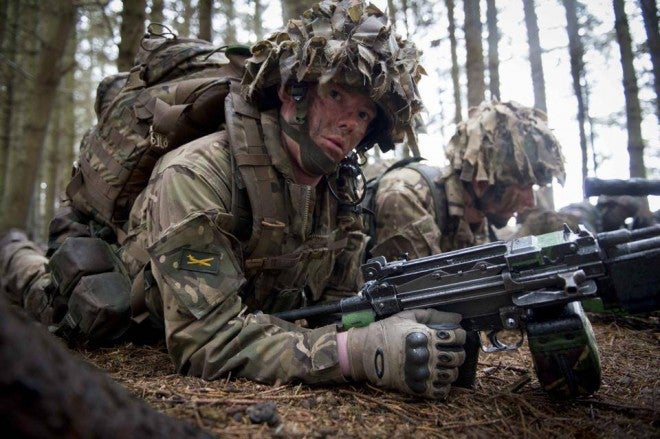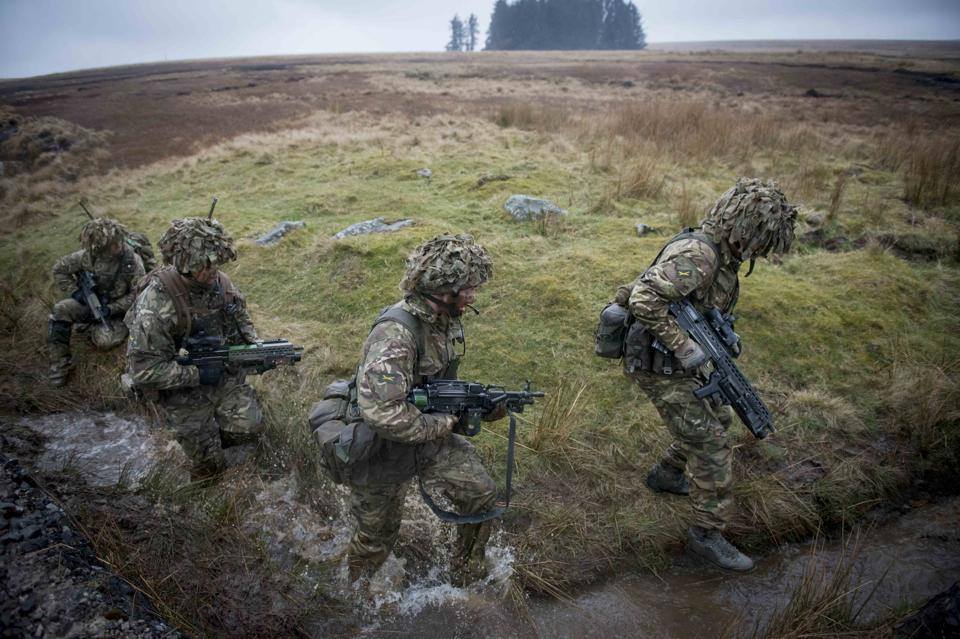A report from Jane’s highlights a move within the British Army to review the requirements and usage of their LMG, the famously nicknamed “Minimi” (FN Para Minimi), and their M6-640 Commando 60 mm mortar system. Both of these weapon systems are currently fireteam (Minimi) and platoon assets (mortar). Essentially, what is going on here, is that the British Army has unofficially concluded that their L85A2 Under Barrel Grenade Launchers (UBGLs) and their L129A1 Sharpshooter rifles (7.62 LMT ARs), have essentially beaten the Minimi and the M6-640 out of a job. In that, the UBGL and the Sharpshooter are more than sufficient for taking on area targets, being an indirect fire asset, and suppressing the enemy than the mortar system and the Minimi are. So why have both sets which would further burden a platoon, when one set is just as efficient, is the question that the British Infantry will be reviewing in the upcoming months.
The British Army is to review the use of belt-fed weapons by dismounted infantry platoons, according to the Ministry of Defence (MoD) official responsible.
The justification for the review is because of the existing variety of the weapon systems in use within a rifle platoon, Lieutenant Colonel Ian Moodie, responsible for the Dismounted Close Combat section within the MoD’s Capability Directorate Combat, said on 14 March. This has made the need for an integral indirect fire capability redundant, he told the SMI Soldier Equipment and Technology Advancement Forum in London.
Currently each British Army infantry fire team is equipped with one L85A2 5.56×45 mm assault rifle (SA80); one L85A2 fitted with an underslung 40 mm grenade launcher (UGL); one L129A1 7.62×51 mm sharpshooter rifle; and one FN Herstal Para Minimi 5.56×45 mm light machine gun (LMG) to provide suppressive fire. Each rifle platoon is also supported by an M6-640 Commando 60 mm mortar; however it was reported that due to the way that it has to be operated, firers are only achieving 3% of first-round hits on target.
The review is looking at the use and potential removal of the LMG and mortar from dismounted infantry platoons – on the basis that the UGL and sharpshooter rifle adequately fulfil current requirements.
Currently the M6-640’s ability to supress targets at ranges of up to the 1,384 m is not a requirement for platoon operations; this can be delivered by company- and battlegroup-controlled weapon systems such as the L16A2 81 mm mortar or the L7A1 (FN MAG) 7.62×51 mm general purpose machine gun (GPMG).
Although a review is being undertaken, no final decision on withdrawing the LMG or the 60 mm mortar has been taken.
The most important and underlying tone to this, or any military small arms program, is that the weapon systems a military chooses, are reflective of the deployment and theory in which that military operates. The weapon system has to fit the job that the military wants its troops to accomplish, roughly speaking of course. In this particular instance, we see yet another modern military branch, after the U.S. Marine Corps, looking into dropping its belt fed weapon systems, in favor of more accurate suppressive fire. This change was quite dramatic and painful in the Marines, with the adoption of the M27, and regulating the M249 SAW to a true machine gunners role in the weapons platoons in the line companies. However, just like the British, the change is reflective of the environments we found ourselves fighting in, i.e. Helmand Province. The British, as did the U.S. Marines saw the small arms environments we were being engaged in, and they weren’t the 300 meters that former wars had seen, but instead were much further out, even out to a kilometer with Taliban PKMs. In that environment, the M249 SAW lost most of its advantage of suppression, in that past 600 meters or so, the light machine gun wasn’t as accurate as a designated marksman’s rifle because it was an area fire weapon system. The British seem to be realizing this out as well. The one qualm I have with this review, is that there doesn’t seem to be anything left to the British Infantry squad, where they can really lay down some accurate suppressive fire, like the M27 does for us. Of course their L85A2s have an automatic selector, but it is not capable of maintaining the amount of suppression that an M27 would, and that a Minimi absolutely would be able to.
The choice of the M6 640 (640mm is the length of the tube, there are 3 total available, each one longer than the 640) mortar seems like a long time coming. Again, this goes back to how each Army operates, and that goes back to how the country is employing them. Maybe in times past, the British Army worked well with a mortar asset attached to every platoon. Contrasting this with the U.S. Marines, 60mm mortars are in a weapons platoon that support the entire line company as a company asset, while 81mm mortars are in a weapons company, that support the battalion as a battalion asset. Somewhat different methodology of employment. I’d assume this goes back to the United States being a comparatively much larger in a logistical light, than the British Army, which can’t afford the sheer amount of support that the U.S. Marines receive. But as the article mentions, the mortar system is made almost redundant at the ranges it is employed at, due to the oftentimes parallel use of the 7.62 L7A1, and the 81mm mortars in use.
 Your Privacy Choices
Your Privacy Choices

